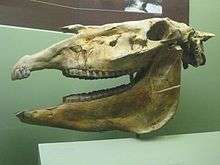Hagerman horse
| Hagerman horse Temporal range: Middle Pliocene to Late Pleistocene | |
|---|---|
 | |
| Mounted skeleton of a Hagerman horse | |
| Scientific classification | |
| Kingdom: | Animalia |
| Phylum: | Chordata |
| Class: | Mammalia |
| Order: | Perissodactyla |
| Family: | Equidae |
| Genus: | Equus |
| Species: | †E. simplicidens |
| Binomial name | |
| †Equus simplicidens Cope, 1892 | |
| Synonyms | |
| |
The Hagerman horse (Equus simplicidens), also called the Hagerman zebra or the American zebra, was a North American species of equid from the Pliocene epoch and the Pleistocene epoch. It was one of the oldest horses of the genus Equus. Discovered in 1928 in Hagerman, Idaho, it is believed to have been similar to the Grévy's zebra of East Africa. It is the state fossil of Idaho.[1]
Classification

The Hagerman horse was given the scientific name of Plesippus shoshonensis in 1930 by a Smithsonian paleontologist named James W. Gidley[2] who led the initial excavations at Hagerman that same year.
However further study by other paleontologists determined that fossils closely resembled fossils of a primitive horse from Texas named Equus simplicidens, named by paleontologist Edward Drinker Cope in 1892. Because of this similarity, the two forms were interpreted[3] to be the same species, and since the name Equus simplicidens was the older name, it was retained following the taxonomic Principle of Priority. The Hagerman fossils represent the oldest widely accepted remains of the genus Equus.
Discovery
A cattle rancher named Elmer Cook discovered some fossil bones on this land in Hagerman, Idaho. In 1928, he showed them to Dr. H. T. Stearns of the U.S. Geological Survey who then passed them on to Dr. James W. Gidley at the Smithsonian Institution. Identified as bones belonging to an extinct horse, the area where the fossils were discovered, called the Hagerman Horse Quarry, was excavated and three tons of specimens were sent back to the Smithsonian in Washington, D.C.
Excavation of the fossils continued into the early 1930s. The Hagerman Horse Quarry floor grew to 5,000 square feet (460 m2) with a backwall 45 feet (14 m) high. Ultimately five nearly complete skeletons, more than 100 skulls, and forty-eight lower jaws as well as numerous isolated bones were found. Some paleontologists believed that such a large amount of fossils found in one location was because of the quarry area being a watering hole at one point. The waterhole could have been where the bones of the Hagerman horses accumulated as injured, old, and ill animals, drawn to water, died there. It is now believed by most paleontologists that an entire herd of these animals probably drowned attempting to ford a flooded river and were swept away in the current and ended up buried in the soft sand at the bottom.

Overview
The Hagerman horse first appeared about 3.5 million years ago. It was approximately 110-145 centimeters (43 to 57 inches) tall at the shoulder. It weighed between 110 and 385 kilograms (385 to 847 pounds). An average Hagerman horse was about the same size as an Arabian horse. It also was relatively stocky with a straight shoulder and thick neck, like a zebra, and a short, narrow, donkey-like skull.
The horse probably lived in grasslands and floodplains, which is what Hagerman was like 3 million years ago. Native North American horses went extinct about 10,000 years ago, at the same time as many other large-bodied species of the period.
References
- ↑ Idaho: Equus simplicidens (state fossil). StateFossils.com Archived October 16, 2007 at the Wayback Machine
- ↑ J.W. Gidley (1930) A new Pliocene horse from Idaho. Journal of Mammalogy 11: 300-303
- ↑ D.E. Savage (1951) late Cenozoic vertebrates of the San Francisco Bay region. University of California Bulletin of the Department of Geological Sciences 28: 215-314
- The Hagerman Horse Quarry
- Hagerman Fossil Beds' Critter Corner - Hagerman Horse - Equus simplicidens, Dr. Greg McDonald
- TalkOrigins.org - Horse Evolution, Kathleen Hunt
Further reading
- Boss, N. H. "Explorations for Fossil Horses in Idaho". Explorations and Field Work of the Smithsonian Institution in 1931. 1932.
- Gazin, C. L. '" Study of the Fossil Horse Remains from the Upper Pliocene of Idaho. Proceedings from the United States National Museum 83(2,985): 281-320. 1936.
- MacFadden, Bruce J. Fossil Horses: Systematics, Paleobiology and Evolution of the Family Equidae. Cambridge Univ. Press, 1992.
- McDonald, H. Gregory. "More than Just Horses", Rocks and Minerals, September/October 1993. Vol. 68:322-326.
- Willoughby, David P. The Empire of Equus. A.S. Barnes and Co., 1974
- Castle Rock Ranch – Hagerman Horse Quarry Land Exchange Environmental Assessment
| ||||||||||||||||||||||